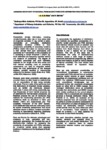Use este identificador para citar ou linkar para este item:
http://www.alice.cnptia.embrapa.br/alice/handle/doc/1026087Registro completo de metadados
| Campo DC | Valor | Idioma |
|---|---|---|
| dc.contributor.author | MAIA, A. de H. N. | pt_BR |
| dc.contributor.author | MEINKE, H. | pt_BR |
| dc.date.accessioned | 2015-10-08T11:11:11Z | pt_BR |
| dc.date.available | 2015-10-08T11:11:11Z | pt_BR |
| dc.date.created | 2015-10-08 | pt_BR |
| dc.date.issued | 2006 | pt_BR |
| dc.identifier.citation | In: INTERNATIONAL CONFERENCE ON SOUTHERN HEMISPHERE METEOROLOGY AND OCEANOGRAPHY, 8., 2006, Foz do Iguaçu,PR. [Anais?]. Foz do Iguaçu,PR: ICSHMO, 2006. p. 569-573. | pt_BR |
| dc.identifier.uri | http://www.alice.cnptia.embrapa.br/alice/handle/doc/1026087 | pt_BR |
| dc.description | Probabilistic climate information, including climate forecasts, often rely on time series data of prognostic variables (Y, eg. rainfall or yield), represented as cumulative distribution probabilities functions (CDFs) or their complement, probability of exceeding functions (POEs). Useful information for decision-making is then derived from such distributions and expressed as Y percentiles or the probability of Y exceeding a certain threshold c (Pr[Y> c]). Such estimates are frequently reported without any measure of uncertainty. The degree of uncertainty associated with such estimates depends on the length of the time series and their internal variability. Lack of uncertainty assessments can lead to misguided beliefs about the true performance of the forecast systems, possibly resulting in inappropriate actions by the decision maker (Potts et al. 1996; Jolliffe 2004; Maia et al. 2006). However, even when uncertainty estimates are provided, these are often based on methods that rely on assumptions of data being normally distributed. This is in spite of the well-known fact that distributions of important climate variables, such as rainfall, are notoriously skewed, particularly in areas with strong seasonality (eg. high frequencies of ?zero? rainfall amounts). As an alternative for Normal-based procedures, we therefore propose the use of distribution free methods for constructing percentile and POE confidence limits as described in Hahn and Meeker (1991) and implemented into ?The Capability Procedure?? of the SAS® System. Such distribution-free tools are particularly useful for spatial uncertainty assessments that would otherwise require a tedious, location-by-location checking of assumptions regarding underlying probability distributions (Maia et al., 2006). Here, we discuss the rationale, advantages and limitations of both, parametric and nonparametric approaches. We illustrate the use of distribution-free methods by assessing the uncertainty of percentiles and POEs estimates for 3-monthly rainfall series from selected locations in Australia and the Southeast of South America. | pt_BR |
| dc.language.iso | por | pt_BR |
| dc.rights | openAccess | pt_BR |
| dc.title | Assessing uncertainty of seasonal probabilistic forecasts: distribution-free confidence limits. | pt_BR |
| dc.type | Artigo em anais e proceedings | pt_BR |
| dc.date.updated | 2015-10-08T11:11:11Z | pt_BR |
| dc.subject.thesagro | Estatística | pt_BR |
| dc.subject.thesagro | Previsão do tempo | pt_BR |
| riaa.ainfo.id | 1026087 | pt_BR |
| riaa.ainfo.lastupdate | 2015-10-08 | pt_BR |
| dc.contributor.institution | ALINE DE HOLANDA NUNES MAIA, CNPMA; H. MEINKE, Department of Primary Industries and Fisheries, Austrália. | pt_BR |
| Aparece nas coleções: | Artigo em anais de congresso (CNPMA)  | |
Arquivos associados a este item:
| Arquivo | Descrição | Tamanho | Formato | |
|---|---|---|---|---|
| 2006AA011.pdf | 3,03 MB | Adobe PDF |  Visualizar/Abrir |









